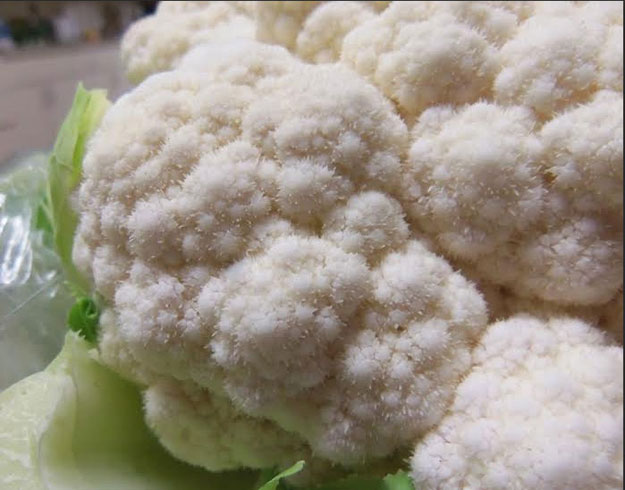In all my classes of teaching the inspection procedures for cauliflower I’ve never had a good picture of this defect, fuzziness on cauliflower. Describing a defect, without a good picture is sometimes difficult.

When you do come across this defect you should be able to identify it, as the heads have a distinct “fuzzy” appearance. I describe the look as being somewhat blurry within the cello wrap. This defect is similar in appearance to riciness. There are few things to note when you do see this defect.
Number One: the USDA has a scoring guideline to use. If the fuzziness is affecting more than 33% of the head’s (curd) surface it is to be scored as a defect, as damage by fuzziness against the 10% tolerance for total defects. If you find over 66% of the head’s surface being affected by fuzziness it is to be scored as a serious damage defect, against the 5% tolerance. When I have seen this defect it is usually affecting almost the entire curd, thus it would be scored against the serious damage tolerance.
The USDA offers a little more of a description. From their own inspection instructions;
Fuzziness is caused by the lengthening of the leafy floral bracts of the bud or flower giving the surface of the curd a velvety or hairy appearance. It frequently develops around the edges of the curd before appearing on other portions.
Number Two: The USDA states this defect is considered as being a condition defect, meaning the USDA feels this defect, or the fuzziness will progress on the head and become worse, affecting a larger portion of the head itself. Personally I have never seen this progress or become worse, nor have I ever seen a good head of cauliflower turn fuzzy in storage. Do I have doubts this will progress…….absolutely. If anyone has any first hand experience to counter my assumption, please share. The cauliflower is not adversely affected, except by the appearance. The defect has no bearing on the taste of the cauliflower. Overmature cauliflower, or cauliflower exposed to extreme heat while growing may taste somewhat bitter, but don’t assume all cauliflower with fuzzy heads will taste bitter.

6 Comments on “Cauliflower- Fuzziness”
Thank you very much for this article. We’re growing cauliflowers for the first time this year and all of them have “fuzzy” heads. I had no idea what it was when I first saw it as I had never seen anything like that before. To my understanding “fuzzy cauliflowers” are still edible, is that correct?
Mine turned fuzzy from the onset and was somewhat yellowed. I assume this to be from not covering heads lightly with the leaves when they ere getting to be tennis ball sized but I am not sure. They did have a couple of green worms on them when I cut. Not sure if safe to eat. I have picture if you want to see.
Thanks for the comments. Cauliflower with fuzziness is still edible, as the defect only affects the appearance.
Thanks for your comment. I as well observed the fuzziness on cauliflowers in Norway. I bought them in cool confition and yet they had it, not as predominant as in your picture. I suggest not ti eat it and to support research on it. In my case, it began on one bud and spread across several, wich to me seems like its a transmittable plant pathogen.
Thanks for your comment. I as well observed the fuzziness on cauliflowers in Norway. I bought them in cool confition and yet they had it, not as predominant as in your picture. I suggest not to eat it and to support research on it. In my case, it began on one bud and spread across several, wich to me seems like its a transmittable plant pathogen.
Fungi can behave opportunistically in other crops such as Fusarium verticilloides or aspergillus flavus in peanuts or botrytis cinerea in tomatoes, wich often exist on the plant prior to becoming a pathogen, but only become one when the plant is stressed.
But we do not yet fully understand what causes ricing or fuzzyness, and it therefore seems recommendable to ask more questions. What can change a plants morphology all of a sudden?
Hormones –> not studied enough?
Fungi on Cauliflower –> not studied enough?
Conclusion –> we need more research, and we can not keep excepting something we could understand.
We need research on exo- and endophytic fungi in brassica oleracea that could influence growth hormomes.
If they influence hormone levels
or interact with cauliflowers stress response or uptake and metabolism then its possible it could be fungi, and if not then its even more interesting to find out what causes it then.